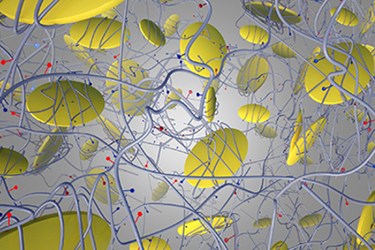New Injectable Nanocomposite Gel Stimulates Bone Healing Without Growth Factors

Engineers have developed a new material that could stimulate bone growth and promote healing in difficult bone breaks and defects, reducing the need for bone graft procedures. The new method works without the use of growth factors, which can cause serious adverse side effects.
A team from Texas A&M University embedded ultrathin nanosilicate particles, composed largely of orthosilicic acid, magnesium, and lithium, into a collagen-based biocompatible hydrogel. According to a university news release, the particles work to promote bone growth through a complex signaling mechanism that “asks” cells to differentiate into bone cells.
Furthemore, the injectable hydrogel has been engineered to remain at the defect site for a specific amount of time by controlling interactions between the nanosilicates and the gelatin. As the bone grows back together and locks into place, the material gradually disintegrates.
The team, led by Akhilesh Gaharwar, published a report of its early findings in ACS Nano. In that study, the material demonstrated both short-term and long-term indications of bone-growth, Gaharwar said. The group saw a threefold increase in alkaline phosphatase activity and fourfold increase in the formation of a mineralized matrix.
An important feature of the material is its lack of protein-based growth factors. In conventional treatments, so much growth factor must be injected in order to stimulate cells that it can lead to significant adverse side effects, which the team wanted to avoid.
“We are trying to overcome these problems by avoiding the use of growth factors as we recapitulate the natural bone-healing process. Our material is a totally different, alternative strategy in which by using minerals we can induce differentiation in the cells and promote formation of bone-like tissue,” Gaharwar said in the news release.
According to the ACS Nano study, the new material demonstrates a number of characteristics conducive to the regeneration of bone. These include: “increased network stiffness and porosity, injectability, and enhanced mineralized matrix formation in a growth-factor-free microenviroment.”
Gaharwar said that he was encouraged by early preclinical studies and predicts that his team’s particles could be put to use in a variety of different biomedical applications.
As part of its research, Gaharwar’s team is also investigating ways in which the gel could be used to print three-dimensional tissue structures loaded with cells. According to Gaharwar, this could lead to custom-built, vascularized scaffolds that could be surgically inserted in cases of more serious injury, where it is not possible to inject the material.
“The dynamic and bioactive nanocomposite gels we have developed show strong promise in bone tissue engineering applications,” said Gaharwar.
Image credit: The Dwight Look College of Engineering, Texas A&M University
